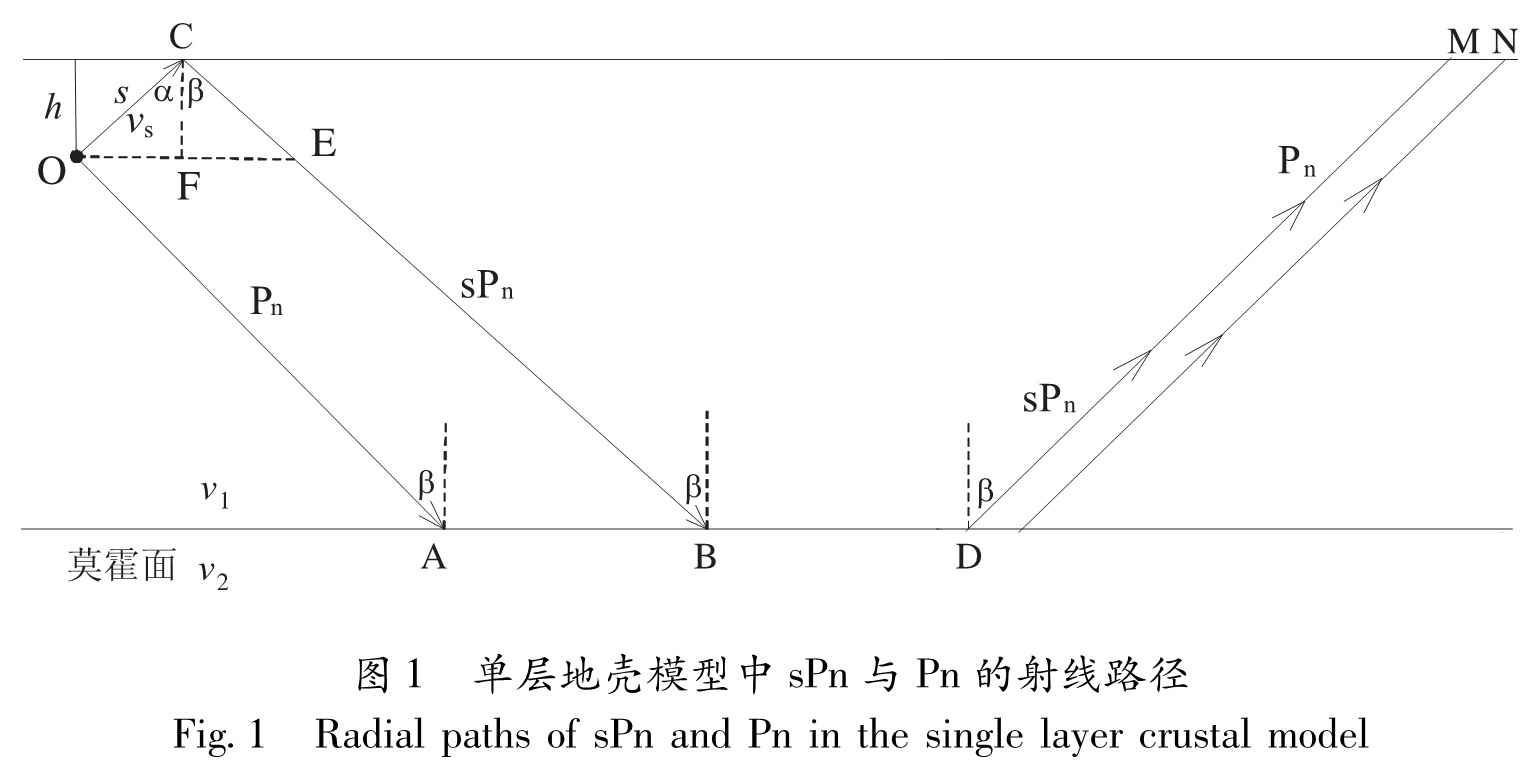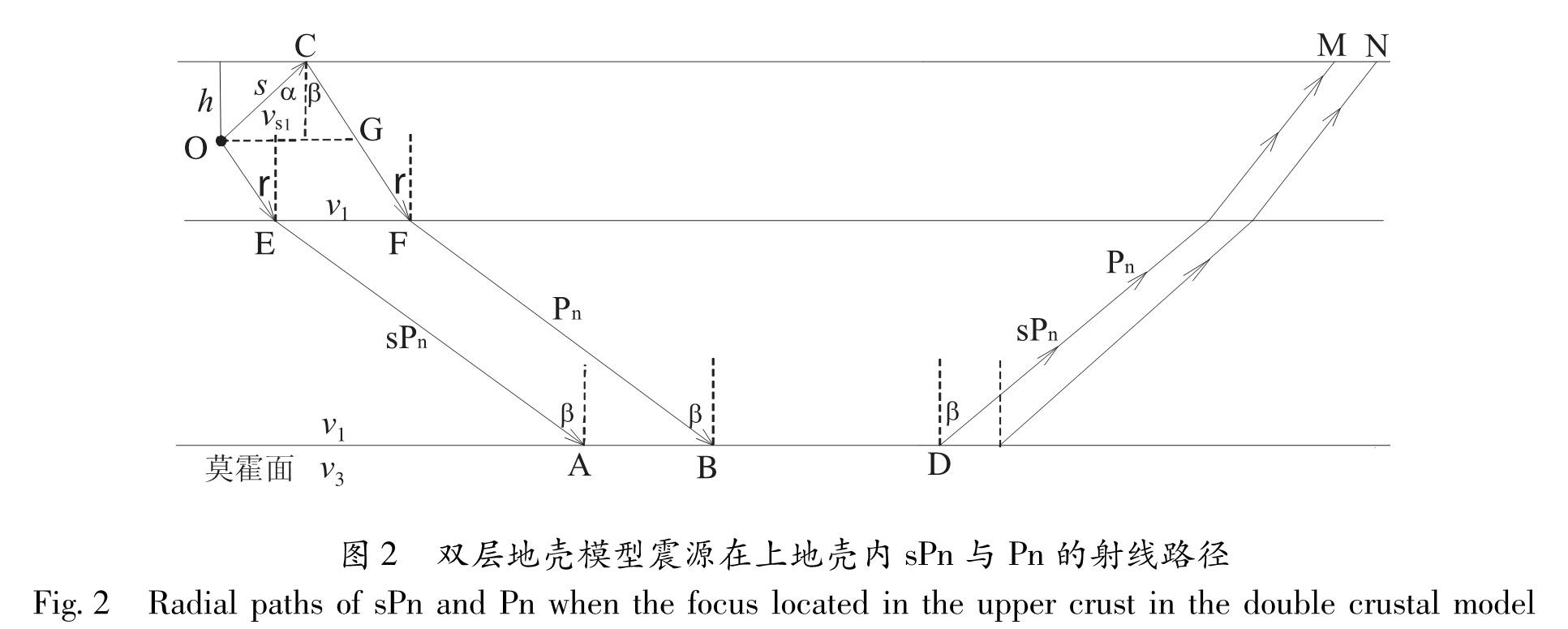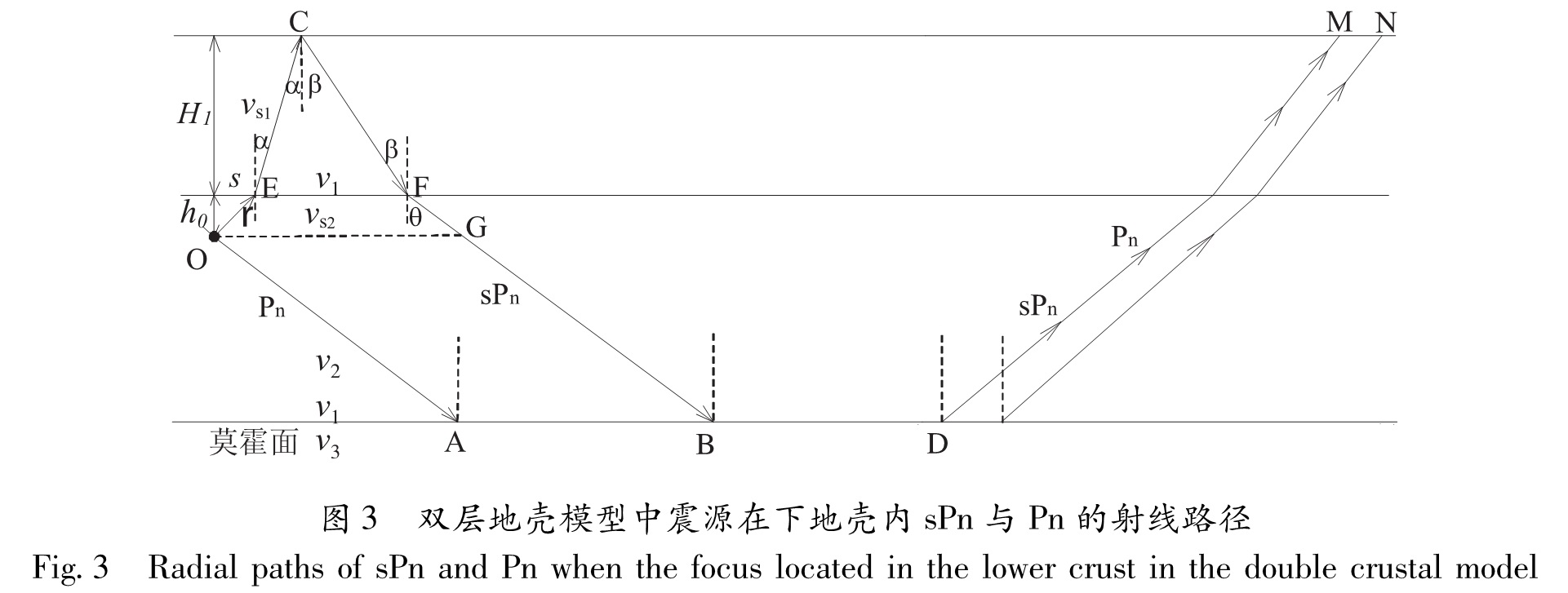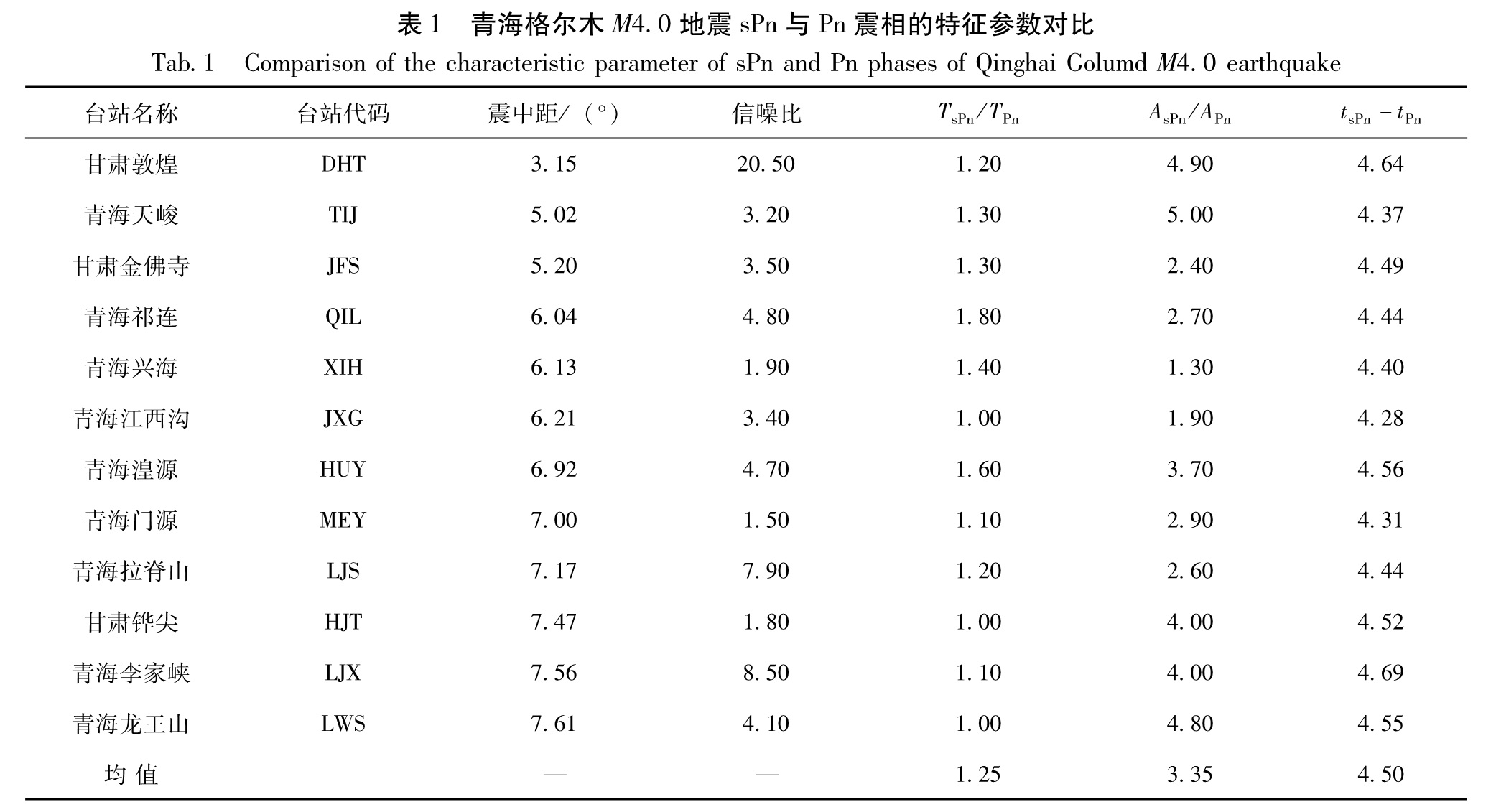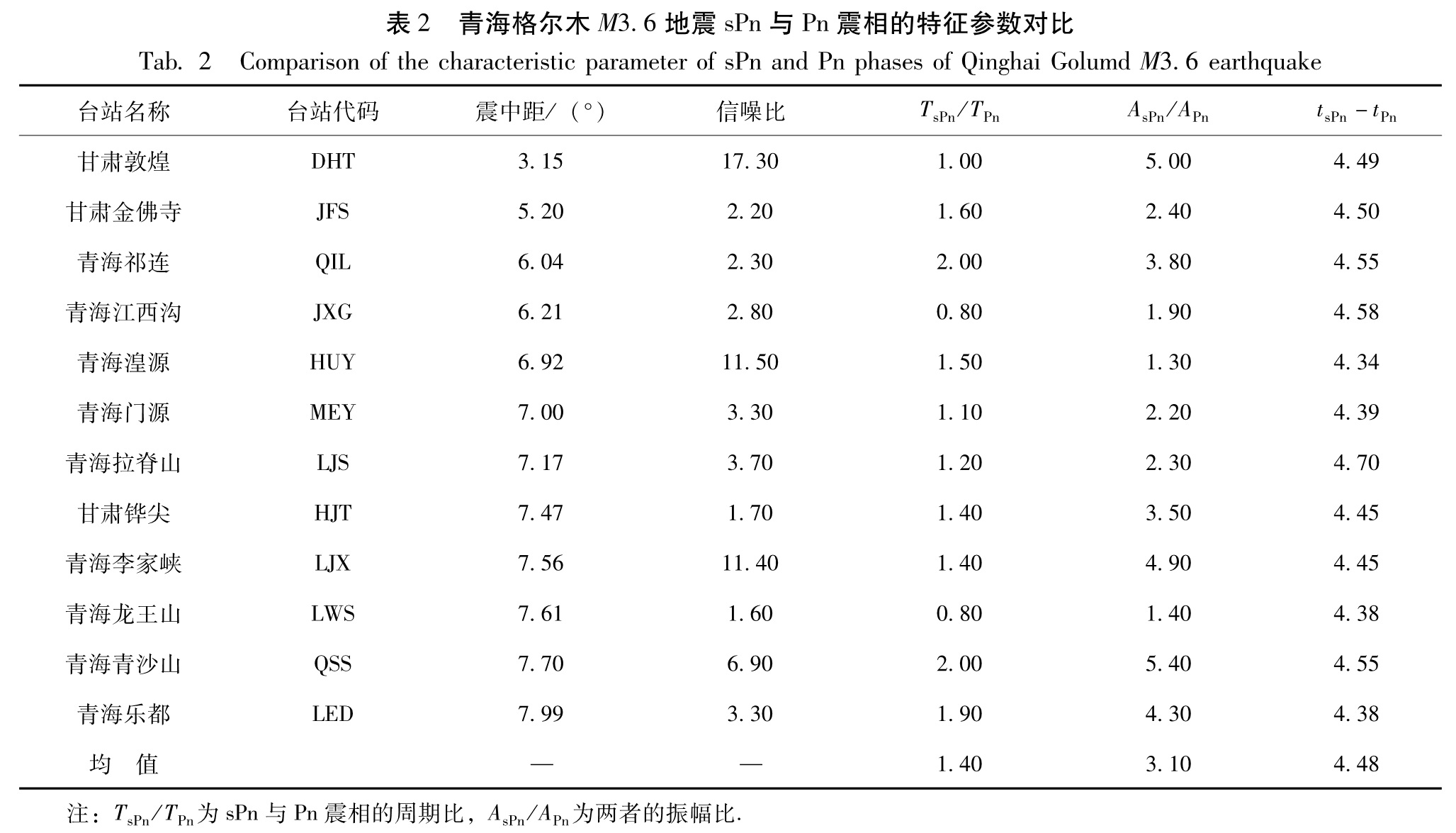基金项目:中国地震局“三结合”课题(152902)资助.
(1.青海省地震局,青海 西宁 810000; 2.西宁市地震局,青海 西宁 810000)
(1.Earthquake Administration of Qinghai Province, Xining 810000, Qinghai, China)(2.Earthquake Administration of Xining City, Xining 810000, Qinghai, China)
sPn phase; focal depth; crustal model; waveform cross-correlation; sliding window correlation method
备注
基金项目:中国地震局“三结合”课题(152902)资助.
利用青海省遥测地震台网的观测记录,对比分析震相特征,提取出了两次地震记录的sPn震相,并分别推导出单、双层地壳模型下的震源深度公式,计算了两次地震事件的震源深度。为验证计算结果的可靠性,利用滑动窗互相关技术进行对比,两者计算出的震源深度相差1.0 km。但分析相关系数图后,认为由于地震震级较小,滑动窗法在识别sPn震相时存在误差,误差修正后得出的结果与人工识别计算的结果一致。
Based on observation data recorded by Qinghai Remote Digital Seismic Network, we exacted the sPn phases of Golmud M4.0 and M3.6 earthquakes by phase characteristic comparison. Then we derived the mathematical formula of focal depth in the case of single-layer and two-layer model respectively, and calculated the focal depth of these two earthquakes. In order to verify the reliability of the calculation results, we compared the focal depth determined by the cross-correlation technique of sliding window with the artificial recognition, and found that the difference of the focal depth by two methods is 1.0 km. After observing the correlation coefficient, there exits an error while we identified the sPn phase by the sliding window method because of the magnitude of the earthquake are small, however, the arrival times of the obtained phases are in agreement with that of the artificial recognition after error correction.
引言
地震定位意指根据地震观测震相反演地震的发震时刻、震源位置等基本地震学参数。它是地震学中最经典、最基本的问题,在地震发生机制及地震构造研究中具有不可替代的作用。随着科技的进步和台站的不断加密,地震的发震时刻和震中位置(震源在地面的垂直投影)已经相对精确。但震源深度依然是一个难以准确测定的地震参数。
1956年前苏联地震科学家A.A.维琴斯卡娅发现了sPn波,她发现各地震台站sPn和Pn震相的到时差不随震中距变化而变化,可以很好约束震源位置。在20世纪70年代初,张诚曾对甘肃地区sPn震相做过一些研究,但限于我国当时的观测环境,sPn震相资料稀少,该方法难以得到大力推广。20世纪70年代起,世界各国陆续建立了数字地震台网,中国的数字地震台网建设起步于20世纪80年代。1983年5月国家地震局与美国地质调查局开始规划设计中美合作的中国数字地震台网(CDSN),各省区域地震台网也陆续成立。而后,随着台网的不断加密,震相记录更为丰富,震相识别更为精确,sPn越来越多地出现在地震观测记录上。众多学者开始利用sPn震相测定震源深度。任克新等(2004)用sPn震相测定了2003年8月16日发生在我国内蒙古地区地震的震源深度。蔡杏辉和邵平荣(2011)总结了发生在我国台湾地区地震的sPn震相特征。洪星等(2006)分析了发生在台湾海峡南部地震的sPn震相特征并在不同地壳模型下用sPn-Pn走时差计算了震源深度。房明山等(1995)给出了华北、山西、华东、西北及四川地区的sPn-Pn走时差对应震源深度表。本文将利用sPn震相计算发生在青海柴达木盆地内两次地震的震源深度。
2015年5月青海格尔木相继发生M4.0、M3.6地震,青海数字地震台网清晰完整地记录了这两次地震的发生过程。这两次地震震中位置相同,地震发生在柴达木盆地内。但由于青海地震台网密度小,台站难以较好地包围震中,台网给出的的震源深度是否准确有待检验。
在这两次地震记录上观测到多个台站出现了sPn震相,本文利用这些观测资料重新计算了震源深度。
1 sPn波的射线路径和走时方程
当地震发生在地壳内时,从震源出发的S波入射到地表,反射转换为P波后入射到莫霍界面,当入射角达到临界角时,沿着莫霍界面传播形成Pn波。由于它是S波转换而来,所以记为sPn波。本文分别以单层和双层地壳模型为例进行讨论。
1.1 单层地壳模型假设v1和vS分别表示地壳内P波和S波的传播速度,v2表示Pn波的传播速度,射线路径如图1所示,其中O点表示震源,h表示震源深度,则sPn与Pn的走时差方程为
Δt=tsPn-tpn=h·(((v22-v2s)1/2)/(v2·vs)+((v22-v21)1/2)/(v2·v1))=K1·h.(1)
所以
h=(Δt)/(K1).(2)
其中K1=((v22-v2S)1/2)/(v2·vS)+((v22-v21)1/2)/(v2·v1),在同一地壳模型下为K1常数。因此,sPn与Pn的到时差仅与震源深度有关。如果已知速度模型和到时差便可以求解震源深度。
1.2 双层地壳模型假设v1、v2分别为P波在上、下地壳内的传播速度,vS1表示S波在上地壳内的传播速度,v3表示Pn波的传播速度,h表示震源深度。
(1)如果震源在上地壳,射线路径如图2所示,则sPn-Pn的走时方程可表示为
tsPn-tPn=h·(((v23-v2S1)1/2)/(v3·vS1)+((v23-v21)1/2)/(v3·v1)).(3)
结果与单层地壳模型一致。
(2)如果震源在下地壳,射线路径如图3所示。其中H1表示上地壳厚度,h0表示震源到上地壳的距离,vS2表示S波在下地壳的传播速度,则sPn-Pn的走时方程可表示为
tsPn-tPn=h0·(((v23-v2S2)1/2)/(v3·vS2)+((v23-v22)1/2)/(v3·v2))+H1·(((v23-v2S1)1/2)/(v3·vS1)+((v23-v21)1/2)/(v3·v1))=K2·h0+C.(4)
其中K2=((v23-v2S2)1/2)/(v3·vS2)+((v23-v22)1/2)/(v3·v2),C=H1·(((v23-v2S1)1/2)/(v3·vs1)+((v23-v21)1/2)/(v3·v1)),震源深度为
h=(Δt-C)/(K2)+H1.(5)
图2 双层地壳模型震源在上地壳内sPn与Pn的射线路径
Fig.2 Radial paths of sPn and Pn when the focus located in the upper crust in the double crustal model图3 双层地壳模型中震源在下地壳内sPn与Pn的射线路径
Fig.3 Radial paths of sPn and Pn when the focus located in the lower crust in the double crustal model由此可以得出sPn震相的一个重要性质,即无论地震发生在单层地壳还是双层地壳内,其与首波Pn的到时差与震中距无关,仅与介质传播速度和震源深度有关。根据已有的研究成果和地质调查结论(赵文津等,2014; 赵俊猛等,2003; 张诚等,1998; 藤吉文,1997; 安昌强等,1993),柴达木盆地速度模型为:上地壳厚度H1=18 km,下地壳厚度H2=34 km,vS1=3.55 km/s,v1=6.14 km/s,vS2=3.85 km/s,v2=6.66 km/s,v3=8.1 km/s。则有:
(1)双层地壳模型,震源在上地壳内(或单层地壳模型),震源深度为
h=(Δt)/(K1)=2.78Δt.(6)
(2)双层地壳模型,震源在下地壳内,震源深度为
h=(Δt-C)/(K2)+H1=3.18Δt-2.6.(7)
如果震源在下地壳内,则满足Δt≥6.47 s。所以,当到时差Δt<6.47 s时,震源位于上地壳内,震源深度使用式(6)计算; 据张国民研究(2000),中国青藏高原地区地震震源深度可达45 km,所以当6.47 s≤Δt≤14.97 s时,震源位于下地壳内,适用式(7)。当震源深度超过52 km时,双层地壳模型不再适用。
2 sPn震相识别与震源深度计算
因为sPn是由S波转换而来,所以它保持着横波的动力学特征,并最终以纵波的形式出现在地震记录上(房明山等,1995; 张少泉,1998; 高立新等,2007),在波形记录上表征为:垂直分量显示清晰,两个水平分量也有明显变化,振幅和周期均大于纵波。根据震相走时表,sPn震相出现在Pn之后、Pg之前,并且根据上述结论,其与首波的到时差不随震中距改变而改变,所以如果将各台站的首波Pn相互对齐,可以比较容易地辨认sPn震相。
在青海格尔木M4.0及M3.6地震中,青海数字地震台网有多个宽频带台站记录到了sPn震相,台站震中距在300~1000 km间。从中选取震相清晰且信噪比较高的台站记录资料进行震源深度计算。根据震相走时表(国家地震局地球物理研究所,1980),震相Pg与 Pn的到时差在10 s以上,而本文观测到的sPn震相与Pn震相的平均到时差为4.5 s,故sPn震相的识别不会被Pg干扰。
在计算sPn与Pn到时差时,因为sPn震相在垂直向和水平向都很发育,所以我们取其震相到时两向平均值,从而尽量减少震相读取引起的误差。在计算震相周期和振幅比时,考虑到这次地震台站震中距均在300 km以上,而且首波一般震相非常微弱,本文采用量取震相后两个周期然后取平均值的方法。由表1、2可以看出,sPn震相的周期略大于Pn震相,平均振幅是Pn震相的3倍多,在波形记录上也可以观测到Pn震相后有一组比较强的波列,持续数个周期。由于利用单台数据求取震源深度时偶然误差较大,所以本文在计算完所有台站的sPn-Pn到时差后,求取平均值。因为sPn-Pn到时差的平均值为4.50 s,小于6.47 s,所以根据上面结论,震源深度计算适用式(6),可得震源深度为12.5 km。这个结果与张诚等(1989)的甘、青震相走时表比较一致。在表1,2中,各台站sPn-Pn的到时差与平均值的差值在0.2 s以内,对应的震源深度误差约为0.5 km; 另据Ma(2010)的研究,地壳模型会引起震源深度10%~15%的误差,对应本文约有1.5 km的误差,所以震源深度总的误差大概为2 km。考虑误差后,这两次地震的震源深度为(12.5±2.0)km。
Tab. 2 Comparison of the characteristic parameter of sPn and Pn phases of Qinghai Golumd M3.6 earthquake表1 青海格尔木M4.0地震sPn与Pn震相的特征参数对比
Tab.1 Comparison of the characteristic parameter of sPn and Pn phases of Qinghai Golumd M4.0 earthquake注:TsPn/TPn为sPn与Pn震相的周期比,AsPn/APn为两者的振幅比.
3 与波形互相关结果对比
由于Pn和sPn同属首波性质,初动振幅较弱,人工识别震相可能存在读取误差。为了验证计算结果,本文进一步利用滑动时窗波形互相关叠加技术提取sPn震相(王俊等,2013; 孙茁等,2014)。其基本原理是,对于同一个地震事件的N条波形记录,两两组对计算相关系数,然后进行叠加、归一化后得到总的互相关系数。其中正峰值大小反映了波形相同极性的相似度,负峰值反映波形之间相反极性的相似度,峰值之间的时移即为各震相到时差。
从表1与表2列出的台站信噪比可以看出,前一地震由于震级大于后一地震,各台的信噪比明显大一些,又因为这两次地震的震中位置相同,所以记录到sPn震相的台站基本相同,因此本文仅对第一个地震事件进行波形互相关计算。从波形记录资料可以看出,各台不同分量sPn的位置差异很小,故本研究中只计算了垂直分量。图4即为各台经过0.5~10 s的带通滤波后按Pn到时对齐后的波形记录图。
由于地震发生于柴达木盆地内部,其莫霍面深度约52 km(赵文津等,2014),故震源深度可假定在5~40 km,依据IASPEI91模型,sPn与Pn的最大理论到时差约为13 s。滑动窗长一般取信号最大周期的1/2(Bensen et al,2007),由于Pn波的周期约为0.5~3 s,所以每次取1.5 s时长进行互相关计算,将12个台站组成的66条互相关系数叠加、归一化后得到Pn与sPn的相关系数图(图5)。从图5中看到在-0.6、3.9、4.2 s处有3个明显的峰值,其相关系数分别为0.91、0.67、0.69,其中标注星号的为自动识别出的两个震相。根据IASPEI91模型,可知前一星号处为Pn震相,后面星号处为sPn震相,两者到时差为4.8 s,根据式(6)可计算出震源深度为13.5 km。但第2、3处的峰值时差仅为0.3 s,结合波形图和IASPEI91模型可以判定为同一震相,可计算出第二个峰值与Pn的到时差为4.5 s, 与人工识别结果的平均值一致。
图5中Pn震相的相关系数达到0.91,表示经过波形相关法拾取的Pn震相走时数据更为可靠。由于sPn震相存在两个相关系数非常接近的峰值,该震相的识别不具有唯一性和排他性,且第二个峰值处起伏尖锐、波形光滑,周期和振幅都有显著变化,具有明显的震相特征,因此本文认为滑动窗方法在此次提取sPn震相时存在误差。这可能与本文研究的地震震级较小、振幅较弱有关,而滑动窗法更适合中强地震的震相走时拾取。但借助滑动窗法可以更为直观地找到目标震相的可能位置,然后通过与波形记录对比确定震相标注的最佳位置。
4 结论与讨论
本文基于sPn震相与Pn震相的到时差不随震中距变化的特性,利用多台数据资料识别出sPn震相,并根据当地地壳模型推出了柴达木盆地地震震源深度公式。这有助于在出现sPn震相时快速精确地测定震源深度,为地震准确定位及后续研究提供更为可靠的地震参数。本文确定了2015年5月青海格尔木M4.0及M3.6两次地震的震源深度为(12.5±2.0)km。
这种计算震源深度的方法简单实用,但其准确性受限于Pn震相和sPn震相识别的精度。因为这两个震相同属于首波,震相不够尖锐、清晰,识别有一定困难,存在读取误差。误差的另一主要来源是地壳模型的误差,包括速度模型的误差、地壳厚度的误差以及介质非泊松体引起的波速比误差。
利用滑动窗互相关技术得到sPn与Pn的到时差为4.8 s,由此计算出震源深度为13.5 km。但仔细分析相关系数图,笔者认为由于本次地震震级较小,滑动窗法在识别sPn震相时存在误差,误差校正后得出的结果与人工识别计算的结果一致。这表示人工识别法计算出的平均震源深度是可靠的。
- 安昌强,宋仲和,陈国英等.1993.中国西北地区剪切波三维速度结构[J].地球物理学报,36(3):317-325.
- 蔡杏辉,邵平荣.2011.中国台湾地区地震sPn震相分析及其震源深度计算[J].山西地震,(1):25-28.
- 房明山,杜安陆,董孝平等. 1995.用sPn震相测定近震震源深度[J].地震地磁观测与研究,16(5):13-18.
- 高立新,刘芳,赵蒙生等.2007.用sPn震相计算震源深度的初步分析与应用[J].西北地震学报,29(3):213-218.
- 国家地震局地球物理研究所.1980.震相走时表便查表[M].北京:地震出版社
- 洪星,叶雯燕,邵平荣等.2006.台湾海峡南部一次5.0级地震的sPn震相分析[J].地震地磁观测与研究,27(3):26-31.
- 任克新,邹立晔,刘瑞丰等.2004.sPn震相计算震源深度的初步分析与应用[J].地震地磁观测与研究,25(3):24-31.
- 孙茁,吴建平,房立华等.2014.利用sPn震相测定芦山Ms7.0级地震余震的震源深度[J].地球物理学报,57(2):430-440.
- 藤吉文.1997.中国地球深部地震探测研究的序幕-柴达木盆地的地壳与上地幔结构和构造[C]//地球物理与中国建设——庆祝中国地球物理学会成立50周年文集.
- 王俊,缪发军,詹小艳等.2013.利用sPn震相精确测定江苏高邮、宝应交界M4.9地震震源深度[J].防灾减灾工程学报,33(3):354-360.
- 张诚,高世垒,邵世勤.1989. 甘青区域地震波走时表[J]. 西北地震学报,(1):11-15.
- 张诚,邵世勤,高世垒.1998.甘青区域地震波走时表的地壳模型的选取[J].地震地磁观测与研究,(2):27-34.
- 张国民,汪素云,李丽等.2000.中国大陆地震震源深度及其构造含义[J].科学通报,47(9):663-668.
- 张少泉.1998.地震波分析与应用[M]. 北京:地震出版社.
- 赵俊猛,张先康,邓宏钊等.2003.拜城-大柴旦剖面的上地壳Q值结构[J].地球物理学报,46(4):503-509.
- 赵文津,吴珍汉,史大年等.2014.昆仑山深部结构与造山机制[J].中国地质,41(1):1-18.
- Bensen G D, Ritzwoller M H, Barmin M P, et al.2007. Processing seismic ambient noisedata to obtain reliable broad-band surface wave dispersion measurements[J].Geophysical Jo-urnal International,169(3):1239-1260.
- Ma S T.2010. Focal depth determination for moderate and small earthquakes by modeling regional depth phases sPg, sPmP,and sPn[J]. BSSA,100(3):1073-1088.
